Yamaha A-S3200 Review – Big hitter
Offering large-scale dynamics for medium-level money, Yamaha’s A-S3200 integrated packs a punch. David Price rolls with it. Read our Yamaha A-S3200 Review.
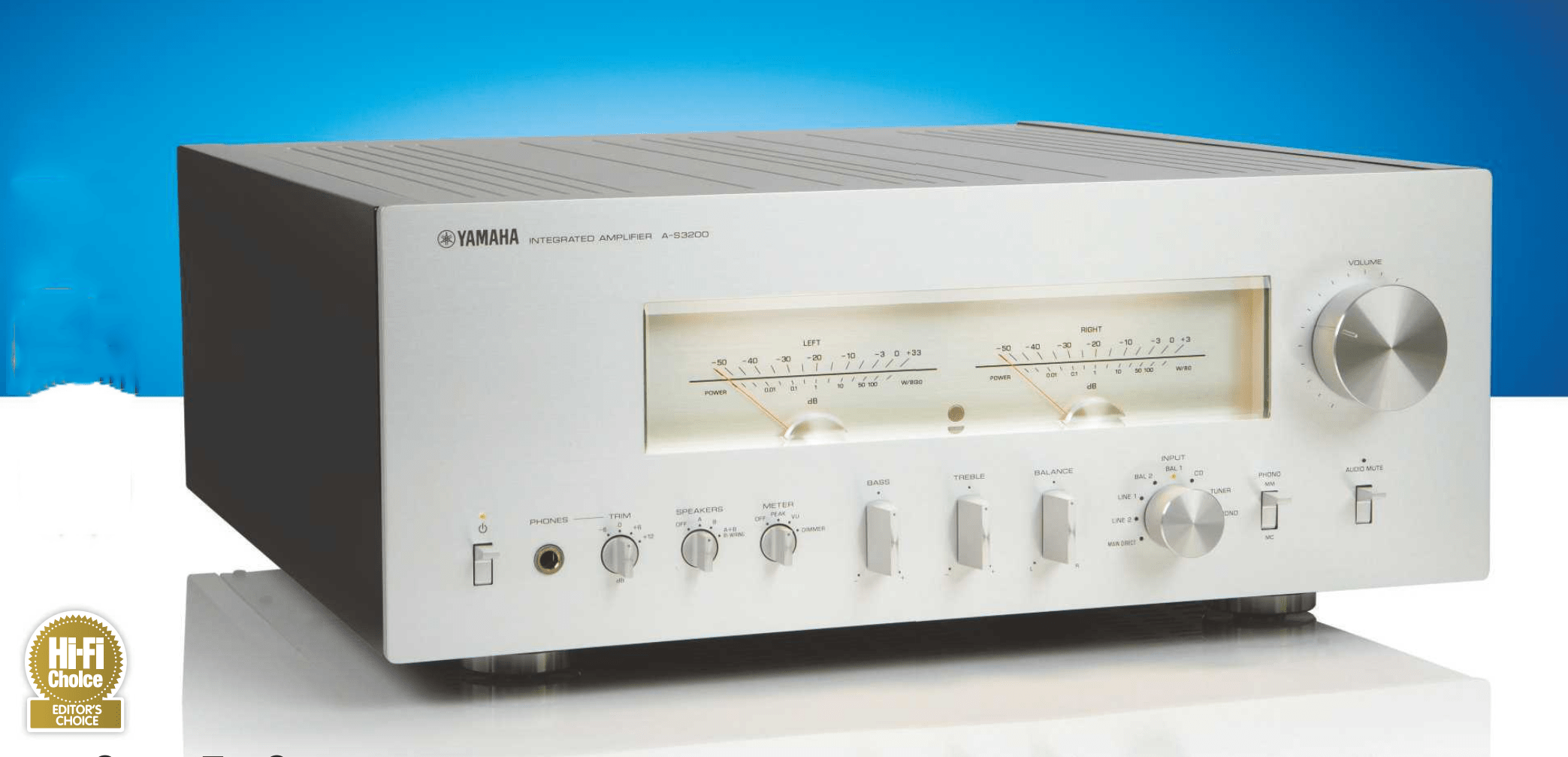
DETAILS
Yamaha A-S3200
ORIGIN Japan/Malaysia
TYPE Integrated amplifier
WEIGHT 24.7kg
DIMENSIONS (WxHxD)435 x180 x464mm
FEATURES
• Claimed power: 2x 100W RMS (8 ohm)
• Switchable MM/ MC phono stage
• Inputs: 2x XLR; 4x RCA; 1x power amp
• Outputs: 2x record; preamp; 6.35mm headphone jack
• Switchable peak/ VU power meters
DISTRIBUTOR Yamaha Electronics UK Ltd.
TELEPHONE 0344 8111116
WEBSITE uk.yamaha.com
There are many things happening now that I never imagined 25 years ago – not least the vinyl revival and the fact that DAC separates are now so central to hi-fi systems. Another thing that I truly didn’t envisage was the return of the Japanese consumer electronics giants to the two-channel stereo market. There was a period around the turn of the millennium when it looked like big companies from Japan were getting out of hi-fi, leaving the market to smaller specialists. Now though, they’re seriously back in business – as Yamaha proves here.
A few years ago, the company made a major push into the market, offering precisely the same blend of quality and value that it did way back in the seventies when the hi-fi market was at its peak. Even more surprising is that its new products are styled in a remarkably similar way – which shows the crisp timelessness of those original amps, tuners and cassette decks. The company has just launched three new integrateds – the A-S1200, A-S2200 and the A-S3200 that you see here, plus the matching NS-3000 speaker. These join the recently introduced top-end 5000 pre-power products, meaning the company offers the full ‘train set’ of audiophile hi-fi separates now.
In my experience, Japanese products tend to offer a contrasting blend of strengths and weaknesses to British ones. Because of their larger production volumes, economies of scale sometimes mean that slightly more expensive components can be used – although this is often spent on the casework instead. UK designs are usually the brainchild of one gifted individual, whereas Japanese ones tend to be done more by committee. The result is that one breed is not necessarily better than the other, but they are invariably different. The A-S3200 is a textbook example of a traditional large, full-feature integrated from the land of the rising sun. Unlike so many of its price rivals, it’s totally devoid of streaming or even DAC functionality. This is an unapologetically old-school integrated, complete with MM/MC phono input and headphone output – almost as if this brave new world of networked digital audio had never happened. Personally, I rather like it like that – because most people who are serious about the subject will already have their favourite DAC and/or streamer, anyway.
It’s not quite top-tier in Yamaha’s product portfolio – that particular accolade is reserved for the 5000 series – but still sports a lot of features from the company’s flagship
The A-S3200’s bass is big and solid, but importantly has next to no overhang
electronics. For example, it uses a fully balanced circuit with floating amplifier design to minimise ground noise, a discrete headphone amplifier and custom feet. A large, low-flux leakage toroidal transformer is fitted, careful mechanical grounding is apparent and thick internal wiring is used. ‘PC-Triple C’ pure copper continuous crystal cables are employed for the loudspeaker feeds from the power amplifier section. Carefully chosen components including four large 22,000/xF/63V block capacitors are fitted, complete with brass screws.
CONNECTIONS
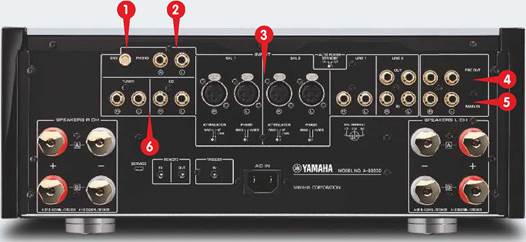
1) Earthing post for turntable
2) MM/MC phono inputs
3) Balanced XLR inputs
4) RCA preamp outputs
5) RCA power amp inputs
6) Tuner and CD phono inputs
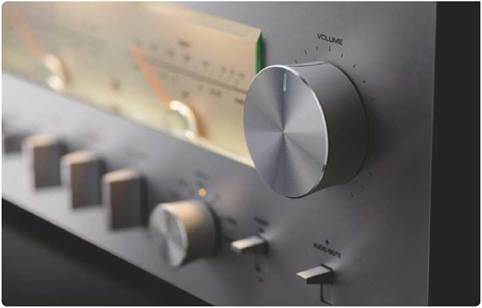
Tactile controls reflect the level of care take on every element
On the outside, we’re treated to a characteristic Yamaha fascia panel in beautiful brushed aluminium, complete with the sort of switchgear it was using four decades ago, and two large, brightly lit central power meters. In the seventies people scoffed at these because they weren’t particularly useful, thanks to the slow ballistics of the needles, yet they’re a lovely retro touch – and the A-S3200’s meters have a switchable peak mode. Despite this amplifier having a plethora of features, its fine
A textbook example of a large, full-feature amplifier from the land of the rising sun ergonomics are such that the front panel doesn’t feel excessively crowded. It’s available in a choice of black or silver, with polished piano black sides; the quality of finish is absolutely superb for the money.
A front panel headphone socket is offered, complete with ‘trim’ level control. There’s switching for two sets of speakers and a choice of peak or VU settings, plus a dim function. The usual bass, treble and balance knobs are present and correct (with centre detents), and there’s a large volume knob to the upper right of the fascia with a lovely buttersmooth action. The main input selector offers a choice between two unbalanced RCA line inputs, two balanced XLR ins, CD, tuner and phono. The ‘main direct’ function bypasses the volume control, plus preamp out, line 2 out and headphone socket – effectively turning it into a power amp. There’s also an MM/MC phono preamp selector, to the right. A muting switch completes the picture.
Yamaha claims a punchy 100W RMS per channel into 8ohm and 150W into 4, for this Class AB design – which is more than most people will ever need. The power comes not via discrete transistors, but as is the usual practice these days, MOSFET power modules. Interestingly, the phono preamplifier does use discrete transistors, and is very neatly laid out in a separate circuit board using good-quality components. It would have been so much easier and cheaper for Yamaha to have simply fitted a basic op-amp to do this job – so it shows a commendable level of seriousness about vinyl.
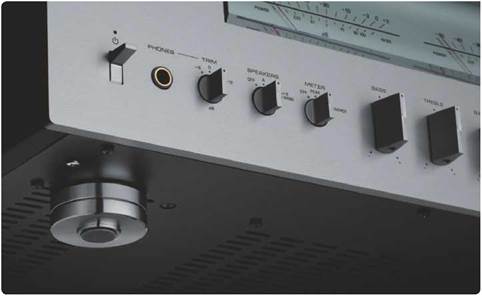
Heavy-duty brass feet add to the battleship-like build quality
Sound quality
Standout facets area crisp, detailed and precise midband along with effortless and authoritative power delivery. For example, feed the Yamaha with some punchy eighties pop from Duran Duran, and Last Chance On The Stairway comes over in a really commanding way. Although not the sort of programme material you’d immediately classify as ‘audiophile’, this is still a well recorded track from the twilight years of analogue. There’s a lot going on, including a gutsy bassline and an energetic midband. Even at highish levels, driving my big Yamaha NS-1000M loudspeaker, this amp doesn’t flinch; its bottom end is powerful and expressive, and never shows any sign of running out of puff even at high volumes on crescendos.
Although the A-S3200 never sounds edgy or volatile, its clean and forensic midband is subtly tonally ‘well lit’. Heavily modulated nineties electronic dance proves more palatable than expected; Nookie’s The Sound Of Music doesn’t assault my sensitive earholes anywhere near as much as some amps I’ve heard, the sound presented with grip, bite and flare-flapping bass.
Another key attribute is the expansive soundstaging; it’s able to recreate a cathedral-like recorded acoustic, if that’s what was originally committed to tape in the studio. Large scale classic rock such as Los Endos by Genesis really fills the room. The soundstage pushes very wide left to right, and is decently three dimensional too. Better than many, the A-S3200 is able to set up a big sound. I am struck by the size and width of Phil Collins’ drum kit, with epic pan rolls that punch through the complex mix. Steve Hackett’s legendary guitar noodling is also a joy, sounding vital and alive.
Rhythmically the Yamaha is a battler. It doesn’t quite have the fluidity and lyricism of some similarly priced tube amps, but still makes music engaging and lively. This is achieved in two ways; firstly its midband has formidable transient speed, with a great rhythmic snap to the proceedings. Secondly, the bass is big and solid, but importantly has next to no overhang. There’s none of that spongy sensation that gives a pleasant bloom to proceedings, yet which slurs one note into the next. For these reasons, I find subtle pop songs like The Dolphin Brothers’ Catch The Fall sound surprisingly infectious through this bruiser. This big integrated amplifier is fast, detailed and lithe enough to make even relatively intricate music sound like it has a raison d’etre.
Conclusion
This accomplished performer succeeds through its breadth and depth of ability, rather than exceeding in one particular area. It’s a highly capable all-rounder, and many will love its snappy sound and gutsy demeanour. The only downside is its presentation lacks the more gentle, fluid character of some similarly priced valve amps and solid-state designs. As ever, this comes down to taste – so prospective purchasers should audition it if at all possible. Factor in its superb build, neat styling and overall air of quality, and I can’t help but be seriously impressed. Although expensive, the A-S3200 offers fine value for money
OUR VERDICT
How it compare
Naim’s Supernait 3 (HFC 456) is a quintessentially British design that lacks both a DAC and streaming. It goes further by not having any tone controls, and sports just a basic MM phono stage and a power rating of 2x 80W RMS into 8ohm. It sounds more naturally musical than the Yamaha; despite lacking some of its punch it’s still lots of fun to listen to. The big Naim is more fluid, with a much bouncier bass and a more lyrical midband. However, the A-S3200 has a tidier, more precise and controlled musical character.
Q&A
Simon Feben-Harknett
AV Product Specialist, Yamaha

DP: Why did Yamaha re-enter the premium hi-fi two channel market?
SFH: The new lineup of A-S3200, A-S2200 and A-S1200 integrated amplifiers follows in the footsteps of the C-5000 preamp and M-5000 power amplifier, released late 2018. Premium hi-fi has always been recognised as the best way to experience music at home. Yamaha has seen a consistent interest in this and it accounts for over a quarter of our global business.
How did the A-3200 come about?
It was designed by a team of Yamaha engineers, comprising of four electrical, two mechanical and one software. As we had already learnt a lot from the development of the C-5000 and M-5000 pre/power setup, the A-S3200 took one year and three months to create.
Where is it manufactured?
It’s made by Yamaha Electronics Manufacturing in Malaysia; this is just one of many Yamaha factories worldwide, responsible for audio equipment and service parts, which we own and operate with Yamaha staff to ensure the highest quality control standards are met. Being a large and historical company such as Yamaha brings benefits in terms of research and development, specialist manufacturing and the inheritance of knowledge. We have high-powered computer simulation facilities and a number of in-house specialist manufacturing resources readily available – such as woodworking, tooling, metal processing, product process and others. This gives us the ability to turn an idea into reality with very little outside help. Our knowledge of audio spans over 60 years, over this time we were able to collect valuable experiences and expertise within this field.
IN SIGHT
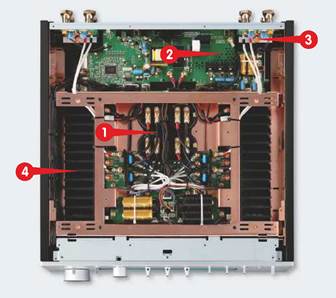
1) Massive toroidal transformer and 4×22,000uF reservoir caps form the heart of its power supply
2) Dedicated MC headamp and MM/ MC phono stage (underneath)
3) Yamaha’s (white) ‘PC-Triple C’ cable connects the power amplifier to the output filter network
4) MOSFET power devices bolted to internal heatsinking
SIZE MATTERS
There’s sometimes a tendency in the West to look at big Japanese companies as faceless corporations, with little in the way of charisma. Yet Yamaha is very much the reverse of this. It has an illustrious history, starting when founder Torakusu Yamaha repaired a broken reed organ back in 1887. He then built his own, and founded his company Nippon Gakki Co. Ltd. 10 years later, selling musical instruments. Yamaha was fascinated by Western science, as well as music theory and tuning, hence adopting three tuning forks as its logo.
After over half a century specialising in musical instruments, Yamaha entered the hi-fi market in 1954 and one year later Yamaha Motor Co. Ltd. was set up. This was a period of huge growth for the company, and by the early seventies it was also a semiconductor manufacturer. That decade was a period of great innovation for Yamaha’s hi-fi division with the launch of the groundbreaking NS-1000 loudspeaker range and the B-1 V-FET power amplifier in 1974. The size and diversity of Yamaha confers great development resources, and Simon Feben-Harknett says that the new A-S3200 takes advantage of precisely these: “We can bring a Yamaha perspective on how music should sound. As a musical instrument manufacturer, we know music from the moment it’s created by the artist.”


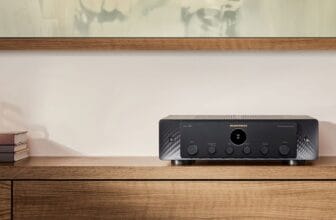
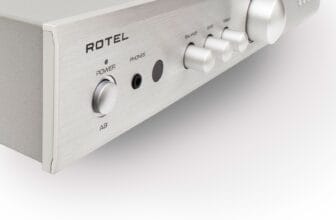
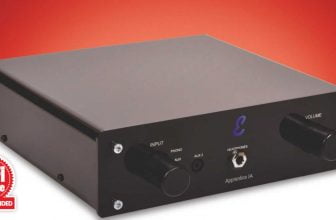
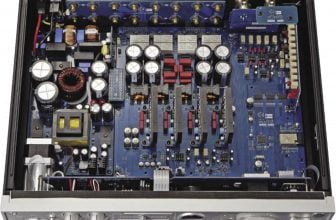
The Yamaha is over-built and over-built is a waste. Audio needs to be built…accordingly and so, the emphasis should be on components and performance…not on size, weight, complexity or an absence of features. The 3200 is worth about $3,500.00 not almost $8,000.00.
Any well-oiled audiophile would purchase a McIntosh 7200 Receiver or the integrated MA7900, replete with quad balanced 32 bit dacs. The McIntosh will be more reliable, consistent and up-gradable while the Yamaha cannot.
When you buy the 3200, you will be paying for limited manufacturing; limited distribution and limited sales…all of which…is carried to the absolute extreme by both the C-5000 and the M-5000, at %10,000.00 each.
What an extreme price to pay for each when, in reality, a McIntosh, with its quad-balanced amps and its quad-balanced SACD/CD Players will out perform the Yamahas.
They are prime examples of Reagan Economics where price and unnecessary panache, go and-to-hand- at the expense of logic and legitimacy!
thanks for sharing 😀
So, I owned a McIntosh 8900 and replaced it with the A-S3200 two weeks ago. All I can tell is that the Yamaha is better. Bass is extraordinary well controlled and the soundstage is simply incredible. The MC phono stage is way better, the Mac sounding thin and less involving in comparison (DV Te Kaitora Rua), while the MM input is comparable. Regarding build quality, the Mac’s flimsy wobbling plastic controls are a joke compared to the solid feel of the A-S3200 all metal buttons. Reliability? My 8900 stalled after a few days. Had to open the case and update the Firmware to get it working again.
Mcintosh is well known to charge more than they actually give. This German reviewer found the previous model, the a-s3000, to be better in every respect than the mcintosh MA7900 integrated amplifier. He did a direct comparison, not a snobbery supposition, between both amplifiers. This A-S3200 is supposed to be at least a tad better than the previous model, so it should easily surpasses the Mcintosh integrated you guess is better just for the sake of being Mcintosh: erster-test-yamaha-a-s3200-das-spezielle-japan-high-end
It always amuses me when I read reviews and comments in the Hi-Fi universe, with their useless comparisons that repeatedly end with MOSFET amplifiers not having the fluidity and sound of tube amps.
Well, apart from the fact that MOSFET transistors, like tubes, have harmonic distortions, what should the Yamaha amplifier sound like, more like a triode or a pentode? To illustrate these absurdities, I recently read the test report of a PASS Int 60, which is supposed to sound like a triode amplifier, and of an Octave V 80 SE, which has been certified as a “transistor-like” amplifier. Welcome onto the fields of cognitive and equally schizophrenic dissonance in the world of psychoacoustic listening experiences!
It seems to me all too often that in the Hi-Fi or High-End scene, in an almost neurotic way, ends and means are twisted. So, the experts organize overproduced recordings from Stockfish Records or any other audiophile labels to find the hair in the soup of a Hi-Fi chain or they fantasize about negligible skin effects in the low five-digit frequency range instead of being inspired by the music they listen to.
In my humble opinion, all electronics has only one purpose. It is supposed to provide joyful means to a 40-year-old record and CD collection, no matter if it is a low-budget production of a newcomer band or the audiophile master cut of a jazz legend. Every amplifier must hold itself back in such a way that it dissolves into music and falls into oblivion. And that is exactly what Yamaha engineers have achieved.
Even its small predecessor, the A-S2100 paired with ATC SCM 40 transducers, disappeared and filled my living room with music and by no means had to hide from one to eight times more expensive competitors such as the Naim Supernait 3, the Mcintosh MA 8900, the Luxmann L-509X, the Marantz PM-10 or even the reference pre/power amplifiers C-5000 and M-5000 from Yamaha-Family. All of them shone a little bit more in some areas but none of them reached the pleasantly modest and outstanding all-round qualities, no matter what kind of music genre you throw at the Yamaha.
And in 2020, the well thought construction of the new A-S3200 let the last curtain fall, moved the music closer to the listener with playful and seemingly shining character, like a rough diamond refined to a jewel.
Anyone talking about over-built technology and throwing parameters such as weight and price or Reagan Economics into the equation, will inevitably miss the point, that the impeccable construction offered by the A-S3200 and its outstanding musicality are very likely to be available only in much more expensive, separate pre and power amplifiers.
Construction and sound quality have their price. The price-performance ratio offered is therefore more than justified. Finally, you won’t miss any inbuilt DAC, when you pair the A-S3200 with a superb Marantz KI-Ruby, which will do far more than a just decent job. Try the phono stage of the Yamaha with a good record player equipped with van den Hul’s DDT II Special and you’ll find your soul carried away by the music. Well done Yamaha!
PS: if you fancy to go all digital, drop the Mc’s and try a DEVIALET 250 Expert Pro!
As an addendum…
the Yamaha A-S3200 specs it power output as 100W into 8 ohms; 150Winto 4 ohms but no spec for 2 ohm?
Now, an interesting piece of audio history, I considered purchasing the A-S3000 but wanted to hook up a pair of Magepans which, quite frankly, are 3.5 – 3.0 ohms. I called Yamaha, in CA, to ask if it were advisiable to connect a pair of Magnepans to the Yamaha?: I was told “No,” NO, because the Yamaha is not designed for long-term 4.0> ohm output and, since, it using a floating ground, the amp could become unstable?
I found this a specious reply…so, I got the # for Yamaha, of Japan, and sure enough, what CA told me was essentially the same thing Japan told me…also, Yamaha will advise you not to hook up either the 3000/3200 to a powered subwoofer; instead, they will advise you to buy the C-5000, which you do hook up a powered subwoofer but not to the M-5000.
Now, I bought the McIntosh 7200 Receiver and I am running a pair of Manepans by using the 7200’s 2 ohm tap.
I was surprised the amount of grip, power and finesse that the 7200 exercised over the Magnepans.
THe 7200 lisits for $7,500.00 and the A-S3200 lists for $7,800.00. You tell me the logic?
There is no malice behind my two reviews…just common sense and practicability.
As an addendum:
A review of the Yamaha A-S3200 Integrated Amp in the September 2020 of Stereophile Magazine, page 65, as reviewed by John Atkinson:
“…that it doesn’t double its maximun power when the load impedence halves suggests that it shouldn’t be used with loudspeakers with impedences that drop much below 4 ohms”-John Atkinson.
Hence, verification on the above commentary, essentially conformed, by both Yamaha, CA. and Yamaha, Japan. For, almost $, you cannot attach a pair of electrostatic speakers to either the A-S3000 or the A-S3200.
David:
The German Reviewer does not understand the sonic benefits of Autoformers…also, I suspect, the german reviewer may have been given some type of consolation by Yamaha?
Plus, you do not compare an amp using autoformers with an amp which does not. There are notable differences…particularly, when Yamaha uses Mosfets as output devices and McIntosh using thermopak output transistors.
The McIntos is more reliable, more consistent, more stable and comes with its DAC1 or you can upgrade to the DAC2. There is no comparison between the 7900 and the 3200.
They are both fine but the McIntosh is cleaner, more stable and you can run Electrstatic Speakers which you cannot do with the Yamaha. Plus, the 7900.00 is a bit cheaper and infinitely better resale value, too.
David:
Responding to your claim that Lowbeats trounched the McIntosh MA7900, I will leave you with tis conclusion of the MA7900:
It is the unmistakable look, the characterful, pleasant sound and the immensely stable, high performance that sets the McIntosh MA 7900 AC apart from the majority of integrated amplifiers in its class. But you can’t reduce it to that. Because its equipment package is a lot more plump than that of most competitors. A power amplifier that lives its retro charm with the most sophisticated technology and sound and offers so many possibilities that it was probably the last amplifier purchase for the future owner.